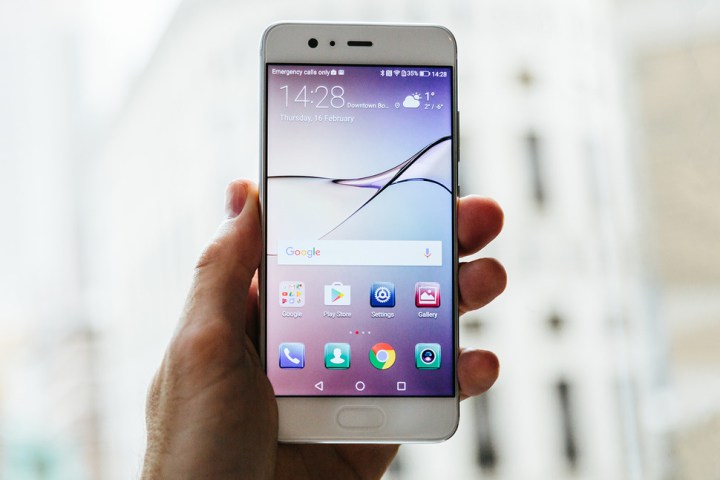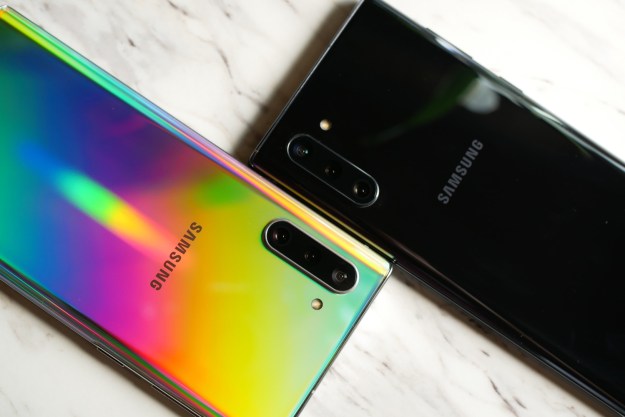
Specs
|
Huawei P10  |
Huawei P10 Plus  |
|
| Size | 145.9 x 69.3 x 7 millimeters (5.72 x 2.73 x 0.28 inches) | 153.5 x 74.2 x 7 millimeters (6.04 x 2.92 x 0.28 inches) |
| Weight | 5.11 ounces | 5.82 ounces |
| Screen | 5.1-inch IPS LCD | 5.5-inch IPS LCD |
| Resolution | 1,920 x 1,080 | 2,560×1,440 |
| OS | Android 7.0 Nougat | Android 7.0 Nougat |
| Storage | 32/64GB | 64/128GB |
| SD Card Slot | Yes | Yes |
| NFC support | Yes | Yes |
| Processor | HiSilicon Kirin 960 | HiSilicon Kirin 960 |
| RAM | 4GB | 4/6GB |
| Connectivity | GSM/HSPA/LTE | GSM/HSPA/LTE |
| Camera | Front 8MP, Rear dual 20MP+12MP | Front 8MP, Rear dual 20MP+12MP |
| Video | 2,160p 4K UHD | 2,160p 4K UHD |
| Bluetooth | Yes, version 4.2 | Yes, version 4.2 |
| Fingerprint sensor | Yes | Yes |
| Water Resistant | No | No |
| Battery | 3,200mAh | 3,750mAh |
| Charger | USB-C | USB-C |
| Quick Charging | Yes | Yes |
| Wireless Charging | No | No |
| Marketplace | Google Play Store | Google Play Store |
| Color offerings | Silver, Rose Gold, Black, Gold, Blue, Green | Silver, Rose Gold, Black, Gold, Blue, Green |
| Availability | TBD | TBD |
| DT Review | Hands-on | Hands-on |
Performance
As previously mentioned, many manufacturers now build a standard and “plus” handset with identical specs. That’s clearly not true of the Huawei P10 and P10 Plus, however. Let’s get something out of the way right now: The Huawei P10 Plus is the better device. The question is, how much better is it?
For starters, the two phones feature the same processor — the HiSilicon Kirin 960 — which is actually a decent chip. According to benchmarks, the chip performs a little better or a little worse than the Qualcomm Snapdragon 820, depending on the benchmark in question. In other words, it’s about on par with Qualcomm‘s 2016 flagship, but not as powerful as the company’s latest chip, the Snapdragon 835.

When it comes to storage and RAM, the difference is more stark. While the standard P10 comes with 4GB and RAM and either 32 or 64GB of storage, the P10 Plus comes in two variants, one with 4GB of
Both devices offer a MicroSD card slot, however, so if you don’t want to shell out cash for the models with more storage, you can just make use of the MicroSD card slot.
These two phones are both powerful, but the Huawei P10 Plus is obviously the better device here.
Winner: Huawei P10 Plus
Design
The P10 and the P10 Plus are almost identical in terms of design — the only difference is their size. The design of the phones is actually quite nice, too. Although each features a unibody look that’s typical of most modern smartphones, they also offer a more comprehensive camera module. The module has been developed in partnership with Leica, which is easy to tell if you glance at the branding right next to the cameras. You’ll also find a basic Huawei logo on the back of the phone.
The front of both phones is also pretty standard. Here, you’ll find a home button that doubles as a fingerprint sensor, as well as a front-facing camera in the upper-left corner.

As previously mentioned, however, the phones differ in size, but only when it comes to some dimensions. Both phones are 7-millimeters thin, and it’s great that Huawei has managed to keep the bulk down on the larger device. The smaller, standard P10 measures 145.9 x 69.3 millimeters, while the larger device sits at 153.5 x 74.2 millimeters. The P10 Plus is heavier, though, and weighs an additional 0.71 ounces.
In the design department, this is a tie.
Winner: Tie
Display
Instead of opting for the same display, Huawei outfitted the P10 Plus with a better alternative. While the standard P10 has a decent LCD screen in its own right — which sits at 5.1-inches and touts 1,920 x 1,080-pixel resolution — the P10 Plus includes a 5.5-inch screen with 2,560 x 1,440-pixel resolution. Although the P10 Plus’ LCD panel is larger, the higher resolution is enough to push it above and beyond the P10’s pixel density. The P10 comes in at 431 pixels per inch, while the P10 Plus sits at 534.

That’s a pretty decent difference. While most people won’t be able to notice the difference, others will, especially those interested in using the device for virtual reality purposes.
Winner: Huawei P10 Plus
Battery life and charging
The two phones use the same charging method. Both feature Huawei’s proprietary SuperCharge technology, which could come in handy in a pinch. We don’t know exactly how long the handsets will last on a single charge just yet, and, sadly, neither of the phones have wireless charging, which is a bit of a bummer.

On paper, it looks like the Huawei P10 Plus has better battery life, but in real-world use, this may not be the case. The P10 touts a 3,200mAh battery, while the P10 Plus offers a 3,750mAh battery. You may also recall, however, that the P10 Plus also has a higher-resolution screen, which will eat up a lot more battery than the display on the P10. So, they may actually end up lasting around the same amount of time as one another when put to use. The P10 may even last longer.
When it comes down to it, however, we’ll have to wait until we can perform more tests to determine a winner in the battery department.
Winner: Tie
Camera
Huawei has gone all in for the cameras on the P10 and P10 Plus, and it has worked with renowned camera maker Leica on the camera modules for both phones. That’s good news for those wanting a device with a top-tier camera. While at first glance you might assume that the cameras are the same on both phones, this isn’t actually the case.

In the P10, you’ll find dual Summarit lenses, one of which is a 20-megapixel monochrome sensor and the other a 12-megapixel color camera. The two cameras work in conjunction to create more detailed and in-depth shots, which is certainly welcome.
While the sensors in the P10 Plus are the same type and feature the same megapixel count, they’re Leica Summilux sensors, which should provide sharper and brighter shots. Moreover, unlike the f/2.2 aperture in the Huawei P10, the camera in the P10 Plus offers a f/1.8 aperture.
Unlike previous Huawei smartphones, this partnership with Leica extends beyond the rear-facing camera. The front-facing shooter on both phones is also built by Leica.
Because the sensors in the P10 Plus are slightly better, this winner is clear.
Winner: Huawei P10 Plus
Software
Both smartphones feature Android 7.0 Nougat, which is the latest version of Google’s mobile operating system. On top of that, each device boasts Huawei’s EMUI 5.1 software, which brings a number of great features to the handsets. These include enhanced machine learning, along with better photo-tagging and video-generating software.

Android 7.0, as a whole, also brings some great features. The software boasts better multitasking features thanks to a new split-screen mode, for instance, as well as shortcuts that allow you to quickly access features from the home screen.
However, because the phones both have Android 7.0 and Huawei’s EMUI 5.1, this one is a tie.
Winner: Tie
Durability
The two phones are identical in the durability department. While reports indicate that they do have “waterproofing,” the level of waterproofing is unspecified. Thanks to their metal body and inclusion of Gorilla Glass 5, however, they should both be able to withstand a few drops.
Both phones seem durable enough, but like any device, you should be careful with them regardless. That said, we always recommend buying a protective case for your phone.
Winner: Tie
Price and availability
Unfortunately, neither of the two devices will make their way to the United States, though they will be available in much of Europe and Asia. Considering the P10 Plus is a better phone, you might expect it cost quite a bit extra. Thankfully, it doesn’t. While the P10 comes in at 650 euros — which equates to around $690 — the P10 Plus comes in at 700 euros, or $743. This is a small price to pay for the extra features afforded by the P10 Plus, so if you have that extra 50 euros, we certainly recommend the P10 Plus over the P10. Nonetheless, since the P10 is cheaper, it wins the pricing section.
Winner: Huawei P10
Overall winner: Huawei P10 Plus
There’s a clear winner here, and that’s the Huawei P10 Plus. However, most people will be fine with what the P10 has to offer. If you like gaming, virtual reality, or running multiple apps at a time, opting for a P10 Plus with RAM may be the better option for you. If, however, you don’t need that extra power, the P10 is still a great phone.
Of course, there’s also the question of size. A 5.5-inch display might be a bit much for some people, but others may appreciate the extra real estate, especially if you like to stream video content on the go.
Editors' Recommendations
- The best Samsung Galaxy Note 10 Plus cases and covers
- Common Samsung Galaxy S10, S10 Plus, and S10e problems and how to fix them
- OnePlus Nord CE 5G vs. Google Pixel 4a 5G
- The best Samsung Galaxy S8 Plus cases and covers
- Apple iPhone 11 Pro Max vs. Samsung Galaxy Note 10 Plus


